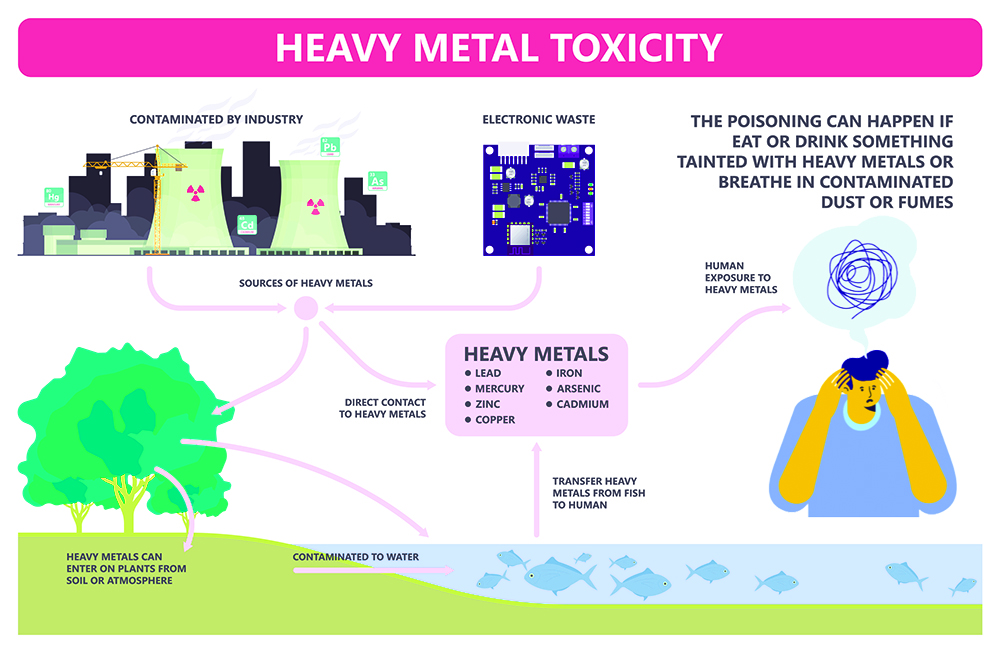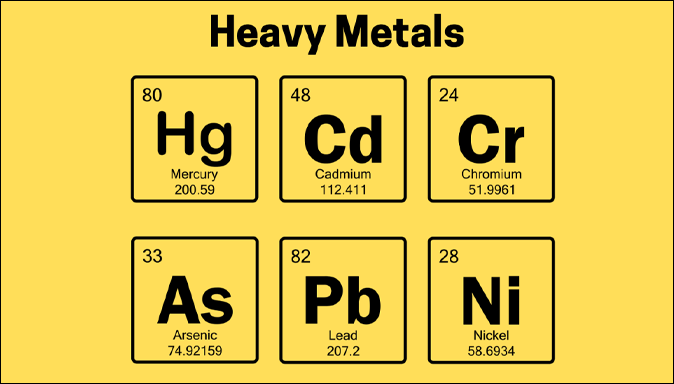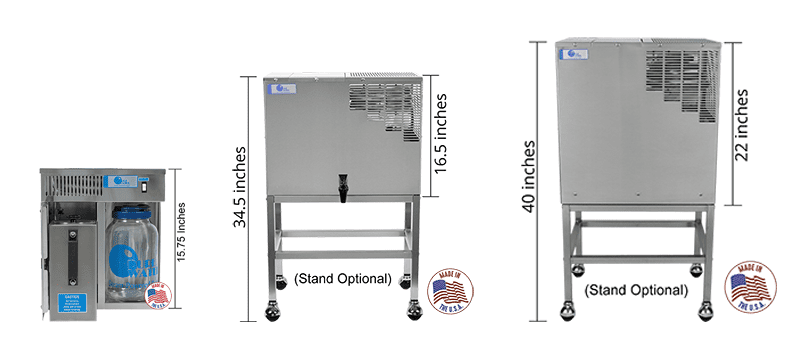What Are Heavy Metals?
Heavy metals are naturally occurring elements that have high atomic weights and densities at least five times greater than that of water. Common examples include lead, mercury, arsenic, cadmium, chromium, and nickel. While some heavy metals, like iron and zinc, are essential in small amounts for biological processes, others, such as lead and mercury, are toxic even at low concentrations.
Heavy metals are non-biodegradable, meaning they can persist in the environment for long periods. This persistence makes them particularly hazardous when they enter water systems, as they can accumulate in living organisms over time, causing various health and environmental problems.

How Do Heavy Metals Get in Drinking Water?
Heavy metals can enter water supplies through both natural and human-induced processes. Natural sources include the erosion of metal-rich rocks and volcanic activity, which release metals into the soil and water. Human activities, however, are the primary culprits behind the widespread contamination of water sources.
Industrial processes, such as mining, smelting, and manufacturing, often release heavy metals into the environment as byproducts. Agricultural practices, like the use of fertilizers and pesticides, can also introduce metals into groundwater. Additionally, outdated plumbing systems made from lead pipes or fixtures contribute significantly to heavy metal contamination in drinking water.
Once these metals enter the water supply, they can persist indefinitely, making effective filtration and removal essential for protecting human health.
How Can Heavy Metals Affect My Health?
The presence of heavy metals in drinking water poses serious health risks. Each metal affects the body differently, and the extent of harm depends on the type and concentration of the metal, as well as the duration of exposure.
- Lead: Long-term exposure to lead can damage the nervous system, kidneys, and reproductive system. It is especially harmful to children, potentially causing developmental delays, reduced IQ, and behavioral problems.
- Mercury: Mercury exposure can impair brain function and development, leading to memory loss, tremors, and mood swings. Pregnant women and young children are particularly vulnerable.
- Arsenic: Prolonged ingestion of arsenic-contaminated water can cause skin disorders, cardiovascular diseases, and an increased risk of cancer.
- Cadmium: This metal primarily damages the kidneys and bones and can weaken the immune system over time.
- Chromium-6: Known for its carcinogenic properties, chromium-6 exposure has been linked to stomach cancer and reproductive harm.
Given these dangers, it just makes sense to want to remove heavy metals from drinking water.
Can a Pitcher Filter Remove All Heavy Metals?
Water pitcher filters are one of the most commonly used solutions for improving water quality at home. However, their ability to remove heavy metals varies widely depending on the type and quality of the filter.
Most basic pitcher filters rely on activated carbon to reduce contaminants. While activated carbon is somewhat effective at removing chlorine, organic compounds, and some heavy metals like lead, it is not capable of removing all heavy metals, especially those dissolved in water at a molecular level, such as arsenic or mercury.
High-end pitcher filters that combine activated carbon with ion-exchange resins or specialized media can achieve better results. However, even these systems may fall short of completely removing heavy metals, particularly at high contamination levels. Thus, pitcher filters can be a good starting point but are not the most reliable option for comprehensive heavy metal removal.
Can Reverse Osmosis Remove All Heavy Metals?
Reverse osmosis (RO) does more to remove heavy metals from water than pitcher filters. This process involves forcing water through a semi-permeable membrane, which blocks contaminants larger than water molecules, including heavy metals.
Reverse osmosis systems are effective at reducing levels of lead, arsenic, cadmium, chromium, and other metals. However, the efficacy of an RO system depends on proper maintenance. A damaged or fouled membrane can compromise performance, allowing some metals to pass through.
One limitation of reverse osmosis is that it requires high water pressure to operate and may produce significant wastewater.
Can Distillation Remove All Heavy Metals?
Distillation is a powerful method for removing heavy metals from water. This process involves boiling water to create steam and then condensing the steam back into liquid form. Because heavy metals have much higher boiling points than water, they remain behind in the boiling chamber, effectively separating them from the purified water.
Distillation can remove nearly all heavy metals, including lead, arsenic, and mercury, making it one of the most thorough purification techniques. In fact distillation not only removes heavy metals but it can also remove a whole host of other contaminants from bacteria and viruses to organic and inorganic contaminants.
Shop Home Water Distillers

Example: Arsenic in Drinking Water
Acute Symptoms (Short-term exposure to high levels of arsenic)
- Nausea and vomiting: Ingestion of high levels can irritate the stomach.
- Abdominal pain: Stomach cramps or severe gastrointestinal discomfort.
- Diarrhea: Often accompanied by watery stool.
- Muscle cramps or weakness: Arsenic disrupts cellular function.
- Headaches: Can occur due to systemic toxicity.
- Severe fatigue: A result of systemic disruption in energy processes.
- Metallic taste in the mouth.
In extreme cases of acute poisoning, high arsenic exposure can lead to shock, seizures, or even death.
Chronic Symptoms (Long-term exposure to lower levels of arsenic)
- Skin changes:
- Darkening of the skin (hyperpigmentation).
- White patches on the skin (hypopigmentation).
- Thickening or hardening of the skin, especially on the palms and soles (keratosis).
- Hair loss: Chronic exposure can cause hair to thin or fall out.
- Nail changes: Lines or ridges on nails (Mees’ lines) and brittleness.
- Tingling or numbness in extremities: Known as peripheral neuropathy.
- Chronic cough or sore throat: Irritation from arsenic exposure.
- Digestive issues: Ongoing upset stomach, loss of appetite, or persistent diarrhea.
- Fatigue and weakness: Caused by long-term systemic effects.
Severe Health Effects of Long-term Exposure
- Cancer:
- Strongly linked to skin cancer, bladder cancer, and lung cancer.
- Associated with increased risks of kidney and liver cancers.
- Cardiovascular disease: Long-term exposure can cause high blood pressure and cardiovascular damage.
- Diabetes: Chronic arsenic exposure is linked to increased risk of type 2 diabetes.
- Neurological effects:
- Impaired cognitive function and memory.
- Behavioral changes and depression.
- Long-term exposure in children can lead to developmental and learning difficulties.
- Lung damage: Increased risk of chronic respiratory diseases.
- Weakened immune system: Increased vulnerability to infections.
Heavy Metals In Your Drinking Water Are a Real Concern
Heavy metals in drinking water are a serious concern that requires proactive measures. People often focus on water taste or smell, but we should be even more focused on drinking contaminant free water. Short term high exposure will cause more obvious symptoms for many, but what about long term low exposure? Symptoms can be vague or mimic other illnesses leaving you feeling tired, sick and frustrated. Take control of your drinking water and protect yourself and your family by investing in a water distiller.
Sources:
USGS: Arsenic in Drinking Water (https://www.usgs.gov/mission-areas/water-resources/science/arsenic-and-drinking-water?_ga=2.162406394.771288923.1732641763-72344198.1732641762)
PBS: 2.1 million Americans use water wells with hazardous levels of arsenic (https://www.pbs.org/newshour/science/2-1-million-americans-use-water-wells-with-hazardous-levels-of-arsenic-usgs-estimates)
Dartmouth University: Arsenic and You (https://sites.dartmouth.edu/arsenicandyou/locations-with-higher-risk-of-arsenic-exposure/)
World Health Organization: Arsenic (https://www.who.int/news-room/fact-sheets/detail/arsenic)
EPA: Basic Information about Lead in Drinking Water (https://www.epa.gov/ground-water-and-drinking-water/basic-information-about-lead-drinking-water)
EWG Database: (https://www.ewg.org/tapwater/contaminant.php?contamcode=1035)






Leave a Reply